Executive Summary
- Simpler, conventional MIG equipment replaced confusing Pulsed MIG equipment that was overkill for the job at hand.
- Adjustable run-in speed on welders eliminated popping and spatter often encountered during arc starts.
- Plasma cutter performance alone provided a 7.5 month payback time and 62.7 percent ROI with the Spectrum.
- New Spectrum plasma cutters do the work of two older plasma cutters and are able to cut steel faster and with minimal slag clean-up.
- Auto-Line™ technology allows IAC’s workers to plug in Miller equipment to any plug around the world without worrying about dirty power.
The War On Error
Armored car expert standardizes on Millermatic® 251 MIG welder and Spectrum® plasma cutters to simplify welding and ensure consistency
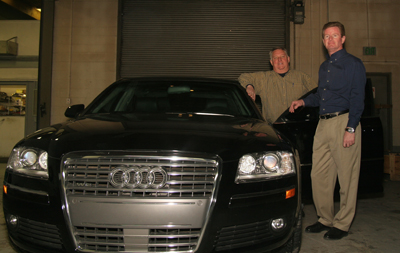 |
The vehicle looks like an ordinary Audi, but after the efforts of IAC’s Ed Fox, plant manager (L), Kirk Matheson, operations director and their team of associates, it can now stop a .44 magnum bullet.
|
International Armoring Corporation (IAC) of Ogden, Utah is the world leader in the design and manufacture of armored bullet-resistant passenger and special purpose vehicles. Its business is protecting VIPs in transit. Past clientele include The Vatican, presidents of powerful nations and, generally, people who wish to remain anonymous and nameless. Celebrity vanity plates get duct taped to maintain the confidentiality of the vehicle’s owner during the armoring process. Ex-special forces customers protecting political VIPs often add extra options, including tack dispensers to flatten tires, electric shock door handles and a tear gas release.
The company’s customers may sound like characters out of a James Bond film, but the challenges IAC faces every day are the same as any other manufacturer: produce a product in time to meet customer needs while maintaining high quality standards. What sets IAC apart is the caliber of its product and the international locations where its products and employees work.
“Our associates always remember that an armored car is used for security and that people’s lives may be endangered every time they go for a ride,” says Kirk Matheson, director of operations, IAC. “If we don’t make a weld correctly, put abrasion resistant (tempered) steel in the right area or use the right technology or welding processes, we could jeopardize people’s lives. That’s why we work very hard to eliminate potential sources of error.”
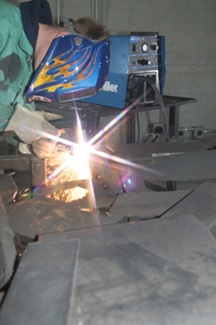 |
IAC fabricator Joe Western uses the Spectrum plasma cutterto free the individual AR500 steel shapes from the main plate, as well as to cut special shapes when necessary.
|
As one of these error-eliminating steps, IAC recently turned to Miller Electric Mfg. Co, and Airgas-Intermountain Inc. to outfit the company’s Ogden plant and its six international facilities with Millermatic® 251 all-in-one MIG welders and Spectrum plasma cutters. Adding the Millermatic 251’s has helped guarantee welding consistency, while the Spectrum has doubled cutting performance and improved parts life dramatically at IAC. Tip savings alone produced a 7.5-month payback time and 62.7 percent ROI for investing in a new Spectrum.
Remaining Anonymous
IAC has built more than 3,500 armored vehicles since going into business in 1993. The company excels in combining traditional steel plates with selective use of lightweight synthetic laminates and molded armor. This method of armoring keeps the car’s weight down and helps the vehicle remain relatively inconspicuous. A vehicle that is obviously armored is a dead giveaway that an important person is inside and can unnecessarily expose its occupants to an attack.
“An obviously armored car is like driving around with a big target on the side of your car that says ‘there’s someone important in here,’” says Matheson. “For the most part, our clients want their vehicles to look ordinary. For example, some of our U.S. special forces wanted an armored vehicle that looks just like an Iraqi taxi. The President of a major Asian nation has two vans and two SUVs that look like ordinary production vehicles–except that they weigh 12,000 lbs. and can resist an armor-piercing bullet.”
IAC builds each car, whether it’s an SUV or Audi, on a custom basis to meet client needs (in some parts of the world, an axe is the greatest threat). IAC literally deconstructs the car, welds the armoring package inside of it and rebuilds it from the ground up, right down to the leather upholstery.
As word of the skills spread, orders for larger quantities came in, sometimes 50 to 60 vehicles at a time, Matheson and his colleagues began to add equipment and employees to increase productivity and reduce lead times. An SUV that once took 90 days to build now takes two weeks.
The process has been thoroughly streamlined. Pre-cut sheets of armoring (AR500 abrasion resistant steel, for instance) enter IAC’s shop looking like a sheet of parts from a plastic model car kit (see Fig 2). Every IAC associate goes through extensive training so that they know exactly where each of the hundreds of cut and label parts should be welded. But before they can be welded, each part is cut from its sheet using the plasma cutter and is then tack welded into place on its corresponding section of the car. Once a proper fit is achieved, the entire armor package is fully welded into place.
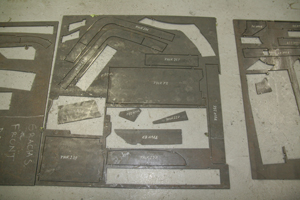 |
Fig. 2: For quality, consistency and accuracy, an outside vender pre-cuts shapes out of AR500 tempered steel plates. By “kitting” parts, IAC also improved throughput by 500 percent in some instance.
|
“You can’t form abrasion resistant steel. It just doesn’t bend,” says Matheson. “You have to cut the steel into small plates and weld them together. That’s the only way that you can form fit armor plate to the contours of the car.”
IAC’s work does not end once the car is put back together and shipped. The company is committed to servicing, or even building, its products anywhere in the world. To meet international needs, IAC assembles kits containing everything necessary to build or repair a vehicle: steel, plasma cutters, MIG welders and consumables, and all the tools for the interior work and protection of the paint job.
Strategic Relationship
Given the time constraints that IAC works under (a client who needs an armored car typically needs it yesterday), it’s important that the company’s fabricators have top of the line equipment and understand how to use each piece of equipment. This is why Miller Electric and Airgas- have built a strategic relationship with IAC that makes sure operators have the best equipment, fully understand each machine’s capabilities and know how to use it to their advantage.
“Part of that is the equipment and part of it is the people,” says Matheson. “The people at Airgas and the people at Miller understand what we need. When I tell Tom Fleenor, our Airgas account manager, that I’ve got to have something tomorrow, it’s here tomorrow. I don’t give it a second thought. It just happens. From an operational perspective—if I’m shipping kits to Spain and if I’m under the gun with 50 cars in the shop—I don’t have time to mess with that stuff and to make sure that it gets done right. Having partners like that makes my job much easier.”
The relationship began by replacing older plasma cutters with Spectrum plasma cutters at its Ogden headquarters. IAC then switched over from a competitive all-in-one pulsed MIG welder to the Millermatic 251. The Miller machines were so easy to use and provided such excellent weld and cutting capabilities that soon IAC was sending Miller equipment out with every kit shipped overseas
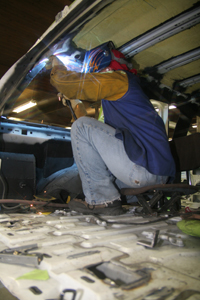 |
“We’re standardizing their business,” says Fleenor. “Wherever they perform work, their employees are familiar with the equipment. They don’t have to spend time getting local people to show them how to use the equipment or make adaptations. They already know how to use it.”
|
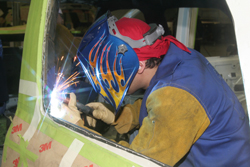 |
An IAC fabricator uses a Millermatic 251 to tack weld steel plates around the D and C posts of this SUV.
|
Plasma ROI
The new Spectrums increased the cutting capacity compared to IAC’s older, 55-amp machines, which in turn made it much easier to cut through 1/4- to 5/16-in. tempered steel IAC uses. Tempered steel is much harder to cut than mild steel due to its alloying materials.
“We also noticed that IAC fabricators had issues with arc starting techniques,” says Fleenor. “When we brought in the Spectrum, we trained them on proper piercing techniques, how to start and end a cut properly and how to hold a proper standoff to ensure consumable longevity.” [See the side bar story on the right for further advice.]
The new equipment and training has worked. IAC plant manager Ed Fox says, “Productivity has increased so much that one of the new Spectrum plasma cutters does the work of two of our older units.” IAC’s fabricators are able to cut through tempered steel much faster than before and with minimal slag clean-up. This also reduces the amount of heat applied to the steel and reduces any chance for warping.
“The Spectrum cuts a lot smoother and quicker than some of the other machines we’ve had in the shop,” notes Fox.
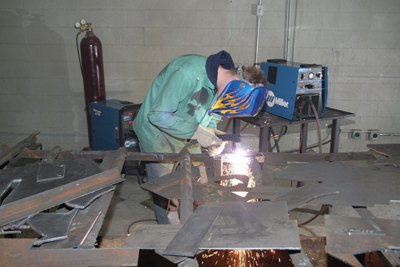 |
With the Spectrum (shown here), Joe Western can plug into any three-phase power source between 176 - 630 volts.
|
In addition to the operational efficiency of the plasma cutters, IAC has achieved two substantial benefits with the new plasma cutters: the ability to run off of any input power in the world and an ROI of more than 62 percent.
Miller’s exclusive Auto-Line™ technology, coupled with LVC® line voltage compensation, enable the Spectrum plasma cutter to automatically connect to any primary input voltage from 176 to 630 V, 50 or 60 Hz power. The Spectrum connects to the same input voltage range, but only uses three-phase power. The Spectrum plasma cutters are extremely lightweight (this model weighs 92 lbs.). Miller’s Wind Tunnel Technology™ prevents airborne contaminants (IAC has a lot of metal shavings from post-weld grinding) from damaging internal components, and the Fan-On-Demand™ cooling system only operates when needed, which reduces the amount of dirt and dust being pulled into the machine. These features guarantee that the Spectrum plasma cutters can plug in and run reliably anywhere in the world.
“I don’t care what the input voltage is,” says Matheson. “As long as they’ve got the grounds and the hot wires straightened out, our operators can put any plugs they need to on the Spectrum. This gives us consistency of equipment, whether it’s here in Ogden or in Kuwait. This enables us to start building or repairing cars the same day we land.” Repair is an important part of IAC’s business, as cars that have been involved in “incidents” typically need to have their protection level brought back up to standard very quickly. Customers typically request that IAC send its own employees, as local personnel have a great chance of being “compromised.”
In addition to versatility, “The increased cutting power and arc starting capabilities of Spectrum plasma cutters improved tip life by a 4:1 ratio,” says Fox. This produced an estimated savings of $34.58 per day, per machine. The long-term effects of these savings are best explained in the following chart (Fig. 6) and show just how quickly the machine pays for itself.
The savings in tip life can also be attributed to the cutting techniques that Miller and Airgas have been teaching IAC’s workers, as well as a post-flow cooling circuit that cools the torch and consumables with post-flow air after the operator has released the trigger. Additional savings (and reduced hassle) have been achieved because IAC can now standardize on one set of plasma consumables, as both units use the same tip.
|
1. Estimated annual savings in tip life
2. Equipment Investment (Spectrum list price)
3. Annual Depreciation (machine list price divided by five years)
4. Annual Savings After Depreciation (Line 1 minus Line 3)
5. Profit After Taxes (66 percent of Line 4)
6. Annual Cash Savings (Line 5 plus Line 3)
Return on Investment (Line 2 divided by Line 6 multiplied by 100)
Payback Period (Line 2 divided by Line 6 multiplied by 12 months)
|
$8,645
$3,737
$747.40
$7,897.60
$5,212.42
$5,959.82
62.7 percent
7.5 months
|
Fig. 6—Spectrum ROI and payback calculation
Simplified Operation
IAC had been using a competitor’s MIG welders in its Ogden plant when an order came in from a major Detroit automotive manufacturer for 13 prototype vehicles. The vehicle’s design specified the use of a pulsed MIG welding process with a complicated all-in-one welding system.
“The system the auto maker recommended had more gadgets and buttons and pulse controls on it, and none of my guys could weld with it,” says Matheson.
IAC reported the mismatch of equipment and processes to the car manufacturer. The manufacturer sent out an expert to inspect the process. He couldn’t get the machine to work in IAC’s application either. After numerous and futile attempts to get the power source to work in this application, IAC turned to Miller and Airgas for help. They, in turn, worked with Wayne Western, welding instructor and C.W.I. with Ogden Weber Applied Technology College, to write a specification for this job using the Millermatic 251. The rest is history.
“The Millermatic 251 was perfect for IAC because it had a simple operator interface, and some IAC employees do not speak English as their first language,” says Jim Truett, district manager, Miller Electric. “Non-destructive and destructive weld testing proved that conventional MIG welding provided the necessary mechanical specifications. We knew it was the right combination of welding output, performance and operator skill level to help IAC excel at this project.”
IAC had a new batch of 251s in the next week and, after seeing the demonstration of the Millermatic 251 and its welding capability, the car manufacturer signed off on the switch to Miller. The simplicity of the Millermatic’s operator interface made the difference.
“The Millermatic 251 was a sound choice for us,” says Tomas Kitian a welder at IAC.
“It’s easy to weld and easy to make adjustments, so we get the best quality weld.”
In this application, arc starts were critical for weld quality. The Millermatic 251’s simple run-in speed adjustment on the front panel (there is no need to remove the machine cover) enabled IAC operators to slow down the run-in speed so that the arc would have time to establish itself. This eliminated “poppy” arc starts and associated spatter.
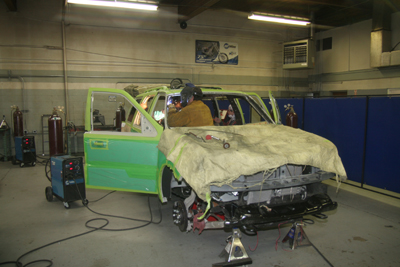 |
IAC standardized on the Millermatic 251 for all its MIG welding because of its simplicity and performance. Mounted on running gear, IAC can easily move several units around a vehicle, which increases throughput.
|
Setting parameters with the Millermatic 251 is easy thanks to the self-calibrating digital meters that allow the operator to preset the voltage and wire speed, as well as display actual settings for five seconds after you stop welding. This helps to ensure repeatability and cuts down on welding errors. These meters also display “help messages” for troubleshooting purposes. This machine features Miller’s Active Arc Stabilizer™ for improved arc starts and a new adjustable run-in control that allows the user to tailor the start to the specific application using a simple knob on the front panel. Like the new plasma cutters, the Millermatic 251 also features Line Voltage Compensation for constant output despite ± 10 percent fluctuations in input power. This makes it an easy welder for IAC employees to use wherever the job takes them, and it enhances process repeatability and consistency of quality. IAC is so happy with the performance of the Millermatic 251 that they now own 30 of the machines
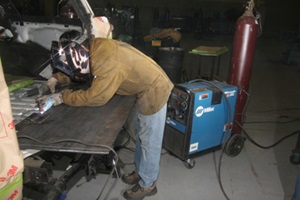 |
|
The Millermatic 251 features digital meters for enhanced precision when setting weld parameters. Shown here, this IAC fabricator welds a reinforced tailgate in place. The 5/16-in. AR500 steel plate will protect the vehicles occupants against grenade blasts and small arms fire.
|
“We have to keep things simple,” says Fox. “If it’s not simple and our welders can’t make adjustments on the fly, then it kills production efficiency and our ability to deliver cars in a timely manner.”
Ultimate Protection
Through its strategic relationship and the use of new equipment in its operations, IAC has improved its welding/cutting quality, increased speed to market and saved a few dollars in the process. It’s a perfect case study in how business partners, working together, can make everyone’s job easier. Knowing that each of the vehicles it produces is responsible for the safety of VIPs worldwide, IAC is thrilled that its welding and cutting equipment is hassle free and provides the same performance every time they strike an arc or cut steel. For a company whose phone rings off the hook “every time a bomb goes off around the globe,” the last thing they need to worry about is their fabrication equipment.
“Having the relationship with Miller and Airgas is a huge deal for me and for IAC as a business,” says Matheson. “Together, we make sure that our products are consistent across the board.”
For more information on IAC, visit www.internationalarmoringcorporation.com. For more information on Millermatic MIG welders and Spectrum plasma cutters, visit www.MillerWelds.com. For more information on Airgas, visit www.Airgas.com.